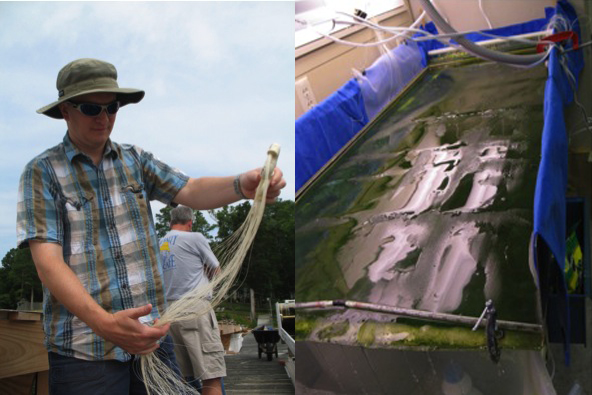
FAYETTEVILLE, Ark. – A team of chemical engineers at the University of Arkansas has developed a method for converting common algae into butanol, a renewable fuel that can be used in existing combustible engines. The green technology benefits from and adds greater value to a process being used now to clean and oxygenate U.S. waterways by removing excess nitrogen and phosphorous from fertilizer in runoff.
“We can make cars go,” said Jamie Hestekin, assistant professor and leader of the project. “Our conversion process is efficient and inexpensive. Butanol has many advantages compared to ethanol, but the coolest thing about this process is that we’re actually making rivers and lakes healthier by growing and harvesting the raw material.”
Hestekin and his research team – undergraduates from the Honors College and several graduate students, including a doctoral student who has discovered a more efficient and technologically superior fermentation method – grow algae on “raceways,” which are long troughs – usually 2 feet wide and ranging from 5-feet to 80-feet long, depending on the scale of the operation. The troughs are made of screens or carpet, although Hestekin said algae will grow on almost any surface.
Algae survive on nitrogen, phosphorous, carbon dioxide and natural sunlight, so the researchers grow algae by running nitrogen- and phosphorous-rich creek water over the surface of the troughs. They enhance this growth by delivering high concentrations of carbon dioxide through hollow fiber membranes that look like long strands of spaghetti. Municipal and state governments, primarily on the East Coast, have implemented large-scale processes similar to this to address so-called “dead zones,” where excess nitrogen and phosphorous have killed fish and plants.
The researchers harvest the algae every five to eight days by vacuuming or scraping it off the screens. After waiting for it to dry, they crush and grind the algae into a fine powder as the means to extract carbohydrates from the plant cells. Carbohydrates are made of sugars and starches. For this project, Hestekin’s team works with starches. They treat the carbohydrates with acid and then heat them to break apart the starches and convert them into simple, natural sugars. They then begin a unique, two-step fermentation process in which organisms turn the sugars into organic acids – butyric, lactic and acetic.
The second stage of the fermentation process focuses on butyric acid and its conversion into butanol. The researchers use a unique process called electrodeionization, a technique developed by one of Hestekin’s doctoral students. This technique involves the use of a special membrane that rapidly and efficiently separates the acids during the application of electrical charges. By quickly isolating butyric acid, the process increases productivity, which makes the conversion process easier and less expensive.
As Hestekin mentioned, Butanol has several significant advantages over ethanol, the current primary additive in gasoline. Butanol releases more energy per unit mass and can be mixed in higher concentrations than ethanol. It is less corrosive than ethanol and can be shipped through existing pipelines. These attributes are in addition to the advantages gleaned from butanol’s source. Unlike corn, algae are not in demand by the food industry. Furthermore, it can be grown virtually anywhere and thus does not require large tracts of valuable farmland.
Hestekin’s team is currently working with the New York City Department of Environmental Protection to create biofuel from algae grown at the Rockaway Wastewater Treatment Plant in Queens.
In addition, a team of 12 students led by Hestekin recently won a national contest for an online video about their design of a biofuel miniprocessing machine that turns algae and other biomass directly into fuel. Planet Forward, a project of the Center for Innovative Media at George Washington University, conducted the online contest. The program features ideas about energy, climate and sustainability on its website and through television specials that air on public television stations across the country. The students’ project will be featured on Planet Forward’s Earth Day special April 8 on PBS.
Research articles detailing findings from algae-to-fuel project have been submitted to Biotechnology and Bioengineering and Separation Science and Technology.
Topics
Contacts
Jamie Hestekin, assistant professor, chemical engineering
College of Engineering
479-575-3492, jhesteki@uark.edu
Matt McGowan, science and research communications officer
University Relations
479-575-4246,
dmcgowa@uark.edu